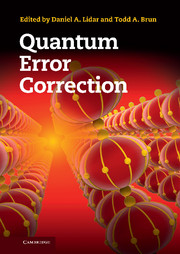Book contents
- Frontmatter
- Contents
- List of contributors
- Prologue
- Preface and guide to the reader
- Acknowledgements
- Part I Background
- Part II Generalized approaches to quantum error correction
- Part III Advanced quantum codes
- Part IV Advanced dynamical decoupling
- Part V Alternative quantum computation approaches
- Part VI Topological methods
- Part VII Applications and implementations
- Part VIII Critical evaluation of fault tolerance
- 25 Hamiltonian methods in quantum error correction and fault tolerance
- 26 Critique of fault-tolerant quantum information processing
- References
- Index
25 - Hamiltonian methods in quantum error correction and fault tolerance
from Part VIII - Critical evaluation of fault tolerance
Published online by Cambridge University Press: 05 September 2013
- Frontmatter
- Contents
- List of contributors
- Prologue
- Preface and guide to the reader
- Acknowledgements
- Part I Background
- Part II Generalized approaches to quantum error correction
- Part III Advanced quantum codes
- Part IV Advanced dynamical decoupling
- Part V Alternative quantum computation approaches
- Part VI Topological methods
- Part VII Applications and implementations
- Part VIII Critical evaluation of fault tolerance
- 25 Hamiltonian methods in quantum error correction and fault tolerance
- 26 Critique of fault-tolerant quantum information processing
- References
- Index
Summary
Introduction
The existence of efficient quantum error correction (QEC), combined with the concept of the accuracy threshold [G98, KLZ98a], inspired confidence that reliable quantum computation is achievable in principle. However, a key point to understand is whether there are physical limitations to resilient quantum computation within this framework. In this chapter, we discuss one of the few situations that still poses some doubts [AHH+02, CSG.-B04, KF05, A06, ALZ06] about the effectiveness of QEC codes: critical environments.
The term “critical environment” originates from condensed matter physics, where it refers to physical systems in which quantum correlations decay as power laws. In such an environment, the Born–Markov approximation used to evaluate decoherence rates cannot be formally justified [W99]. For quantum computation, this fact translates into the appearance of errors that can depend on previous events in the computer history. The ultimate nightmare [AHH+02] is that this memory effect may eventually lead to error probabilities above the threshold value and therefore to the breakdown of resilient quantum computation. In this chapter, our goal is to find the minimal conditions for the existence of a finite threshold value; finding a particular value for the error threshold is a more detailed question which we leave for future work.
- Type
- Chapter
- Information
- Quantum Error Correction , pp. 585 - 611Publisher: Cambridge University PressPrint publication year: 2013



